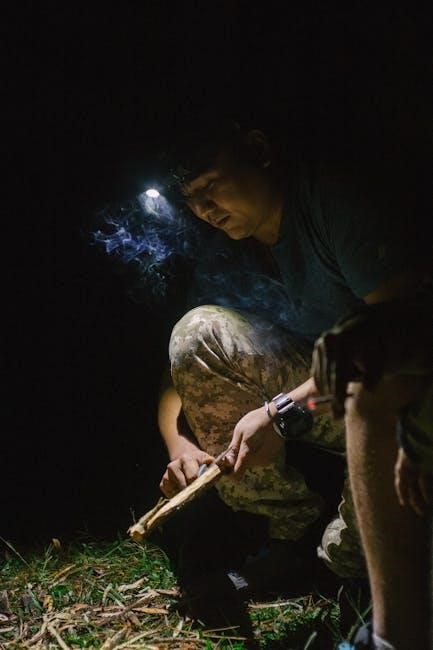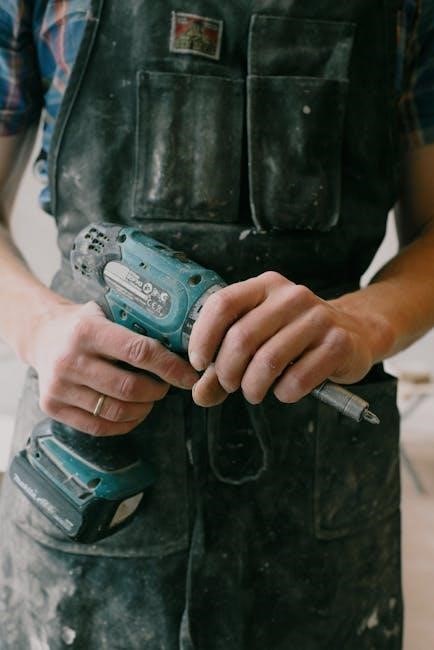Welcome to the GoWISE Pressure Cooker Manual! This guide provides essential information for models GW22700, GW22701, GW22702, GW22703, GW22704, and GW22705. Discover safety tips, key features, and step-by-step instructions to maximize your cooking experience. Designed for both beginners and experienced users, this manual ensures safe and efficient use of your multi-functional electric pressure cooker.
1.1 Overview of the GoWISE Pressure Cooker
The GoWISE Pressure Cooker is a multi-functional electric pressure cooker designed for versatility and efficiency. Available in 6QT, 8QT, and 10QT sizes, it offers 12 preset programs for various cooking needs. With adjustable temperature and pressure settings, it caters to both beginners and experienced cooks. This cooker combines pressure cooking, slow cooking, sautéing, and steaming functions in one unit. Its programmable interface allows customization, while safety features ensure reliable operation. This overview highlights the cooker’s capabilities, making it a valuable addition to any kitchen.
1.2 Importance of Reading the Manual
Reading the GoWISE Pressure Cooker manual is crucial for safe and effective use. It provides detailed safety guidelines, operating instructions, and troubleshooting tips. Understanding the cooker’s features, such as programmable settings and pressure control, ensures optimal performance. The manual also covers proper maintenance and cleaning procedures, extending the cooker’s lifespan. By following the guidelines, users can avoid common mistakes and potential hazards. This comprehensive guide empowers users to make the most of their multi-functional pressure cooker while ensuring a safe and enjoyable cooking experience.
Key Features of the GoWISE Pressure Cooker
The GoWISE Pressure Cooker offers multi-functional capabilities, programmable settings, and adjustable temperature and pressure control. It features 12 preset programs for versatile cooking options.
2.1 Multi-Functional Capabilities
The GoWISE Pressure Cooker is a versatile kitchen appliance designed to handle multiple cooking tasks. It functions as a pressure cooker, slow cooker, rice cooker, yogurt maker, and sauté pan. With its advanced features, you can steam vegetables, keep food warm, and even make cakes. The multi-functional design allows for seamless transitions between cooking methods, making it an ideal choice for home cooks seeking convenience and efficiency. This versatility ensures that you can prepare a wide variety of dishes with ease and precision.
2.2 Programmable Settings and Preset Programs
The GoWISE Pressure Cooker features 12 preset programs, offering convenience for various cooking needs. These programs include options for pressure cooking, slow cooking, sautéing, steaming, and more. Users can easily adjust temperature or time to customize their cooking experience. Additionally, the cooker allows for pressure level adjustments between low and high settings, providing flexibility for different recipes. The programmable interface is user-friendly, ensuring that even novice cooks can achieve perfect results; This combination of preset programs and adjustable settings makes the GoWISE Pressure Cooker a versatile and efficient kitchen companion.
2.3 Adjustable Temperature and Pressure Control
The GoWISE Pressure Cooker offers precise temperature and pressure control, allowing users to customize their cooking experience. With adjustable pressure levels (low and high), you can tailor settings to suit various recipes. The cooker also features programmable temperature control, enabling accurate heat management for delicate or robust dishes. This versatility ensures optimal results, whether you’re cooking tender meats or achieving the perfect texture for grains. The ability to fine-tune temperature and pressure makes the GoWISE Pressure Cooker a powerful tool for both novice and experienced cooks, enhancing your culinary creativity and efficiency.
Safety Precautions and Guidelines
Always read the manual and follow safety guidelines to ensure safe operation. Proper handling and storage are crucial to prevent accidents. Use the pressure cooker on a stable surface and avoid overfilling. Regularly inspect seals and gaskets for wear. Keep children away during operation. Never open the lid while pressure is present. Follow recommended pressure levels and temperature settings. Familiarize yourself with emergency release procedures. Proper maintenance enhances safety and longevity of the appliance. Always unplug when not in use to prevent unintended activation.
3.1 General Safety Tips
Always read the manual before first use to understand proper operation. Ensure the pressure cooker is placed on a stable, heat-resistant surface. Never leave the cooker unattended while in use. Keep children and pets away from the appliance during operation. Avoid touching hot surfaces; use oven mitts or tongs when handling. Do not submerge the base in water or expose it to extreme temperatures. Regularly inspect the lid, seals, and gaskets for wear or damage. Never force the lid open; allow pressure to release naturally or via the quick-release valve. Store the cooker in a dry, cool place when not in use. Always follow recommended pressure levels and cooking times to prevent over-pressurization. Clean the cooker regularly to avoid food residue buildup. Never use abrasive cleaners or scouring pads, as they may damage the surfaces; Ensure the pressure regulator knob is properly set before cooking. Familiarize yourself with the emergency release procedure in case of malfunction. Always unplug the cooker when not in use to prevent accidental activation. Proper maintenance and adherence to these tips will ensure safe and efficient cooking experiences.
3.2 Proper Handling and Storage
Handle the GoWISE Pressure Cooker with care to ensure longevity; Always use oven mitts or tongs when touching hot surfaces. Store the cooker in a cool, dry place, away from direct sunlight. After use, allow the cooker to cool completely before storing. Keep the lid separate to prevent moisture buildup. Clean the cooker thoroughly after each use, avoiding abrasive cleaners. Regularly inspect seals and gaskets for wear. Store accessories in a dry location to prevent rust or damage. Proper handling and storage will maintain the cooker’s performance and extend its lifespan.
3.3 Safety Features of the GoWISE Pressure Cooker
The GoWISE Pressure Cooker is equipped with multiple safety features to ensure safe operation; These include automatic pressure control, a secure lid locking system, and overheating protection. The pressure regulator knob helps maintain safe pressure levels, while the programmable settings prevent excessive temperature or pressure buildup. The cooker also features a safety valve to release excess pressure if needed. Regular maintenance, such as inspecting seals and gaskets, further enhances safety. These features work together to provide a secure cooking environment and prevent potential accidents during use.
Parts and Accessories of the GoWISE Pressure Cooker
The GoWISE Pressure Cooker includes a durable cooking pot, lid, and pressure regulator knob. Accessories like a measuring cup and spoon are provided. Optional extras include racks and additional sealing rings for enhanced functionality.
4.1 Main Components of the Pressure Cooker
The GoWISE Pressure Cooker consists of a main body with a digital display, a pressure regulator knob, and a cooking pot. The lid includes a sealing ring for pressure retention. Additional components include a steam rack, measuring cup, and spoon. The power cord connects the unit to a power source. These parts work together to ensure safe and efficient cooking. Regular inspection of these components is crucial for maintaining performance and safety.
4.2 Accessories Included in the Package
The GoWISE Pressure Cooker comes with essential accessories to enhance your cooking experience. These include a durable ceramic-coated cooking pot, a measuring cup for precise ingredient measurements, and a serving spoon. Additional items like a steam rack and a sealing ring are also provided. These accessories are designed to ensure safe and efficient cooking. The measuring cup helps in portion control, while the serving spoon is ideal for handling cooked meals. These components are carefully selected to complement the cooker’s functionality and make your culinary tasks easier and more enjoyable.
4.3 Optional Accessories for Enhanced Cooking
Optional accessories for the GoWISE Pressure Cooker include additional sealing rings, springform pans, and egg racks. These items can enhance your cooking experience by providing more versatility. Extra sealing rings are useful for maintaining freshness and preventing flavor transfer between dishes. Springform pans are ideal for baking cheesecakes or other desserts directly in the cooker. Egg racks allow for perfectly cooked boiled eggs. These accessories can be purchased separately and are designed to expand the cooker’s functionality, enabling you to explore a wider variety of recipes with ease and convenience.
Installation and Initial Setup
Unboxing your GoWISE Pressure Cooker reveals a sleek, multi-functional appliance. Place it on a stable, heat-resistant surface in your kitchen. Initial setup involves washing all parts thoroughly before first use to ensure cleanliness and safety.
5;1 Unboxing and First Impressions
Unboxing the GoWISE Pressure Cooker reveals a sleek, modern appliance with a ceramic-coated cooking pot, measuring cup, and spoon. The compact design and digital interface create a professional look. First impressions highlight its sturdy build and user-friendly controls. The LCD display and preset buttons offer easy navigation; Included accessories ensure you’re ready to start cooking immediately. Chelsea’s tips on initial setup, like checking the sealing ring, help ensure safety and proper function. The overall presentation inspires confidence, making it an exciting addition to any kitchen.
5.2 Placing the Pressure Cooker in the Kitchen
Position the GoWISE Pressure Cooker on a stable, flat surface in your kitchen, ensuring it is away from direct heat sources and flammable materials. Choose a location with adequate space to accommodate its size, whether it’s the 6QT, 8QT, or 10QT model. Keep it away from children and ensure good ventilation. Avoid placing it near water sources to prevent accidental damage. The cooker’s compact design allows it to fit seamlessly into most kitchens, making it a practical addition to your cooking setup while maintaining safety and functionality.
5.3 Initial Cleaning and Preparation
Before first use, unpack and inspect all components. Wash the inner pot, lid, and accessories with mild soap and warm water. Rinse thoroughly and dry with a soft cloth. Ensure the sealing ring is properly seated and free of debris. Check the pressure valve and regulator knob for any blockages. Place the cooker on a stable surface and familiarize yourself with its controls. For optimal performance, avoid using abrasive cleaners. Allow all parts to air dry before assembly. This preparation ensures your GoWISE Pressure Cooker is ready for safe and efficient cooking.
Operating Instructions for the GoWISE Pressure Cooker
Operate your GoWISE Pressure Cooker with ease using preset programs or manual mode. Adjust temperature, pressure, and time as needed. Always follow safety guidelines for optimal performance and efficiency.
6.1 Basic Operation and Controls
Start by plugging in your GoWISE Pressure Cooker and ensuring the lid is properly locked. Use the control panel to select from 12 preset programs or switch to manual mode. Adjust pressure levels using the “Adjust” button, choosing between low and high settings. The pressure regulator knob allows precise control during cooking. Always ensure the sealing ring is correctly positioned to maintain pressure. For new users, begin with preset programs like “Meat/Stew” or “Soup” to familiarize yourself with the cooker’s functions. Refer to the manual for detailed instructions on specific settings and operations.
6.2 Using Preset Programs for Different Cooking Needs
The GoWISE Pressure Cooker features 12 preset programs for various cooking tasks, including “Meat/Stew,” “Soup,” and more. These programs simplify cooking by automatically setting optimal time and temperature. Select a preset by pressing the corresponding button on the control panel. For example, use the “Rice” program for perfectly cooked grains or “Beans” for tender legumes. Preset programs ensure consistent results with minimal effort. New users can rely on these settings to achieve delicious meals while learning the cooker’s capabilities. Experiment with different presets to explore a wide range of culinary possibilities effortlessly.
6.3 Manual Mode for Custom Cooking
Manual Mode offers flexibility for custom cooking, allowing you to set specific times and temperatures. This feature is ideal for recipes requiring precise control. Use the control panel to adjust cooking duration and temperature settings. For pressure cooking, select either Low or High pressure using the Adjust button. Manual Mode is perfect for experimenting with new recipes or fine-tuning favorite dishes. It provides endless possibilities for creative cooking, ensuring your GoWISE Pressure Cooker adapts to your unique culinary needs. This mode is a must-try for adventurous cooks seeking personalized results.
6.4 Adjusting Pressure Levels
Adjusting pressure levels on your GoWISE Pressure Cooker is straightforward. Use the Adjust button to switch between Low and High pressure settings, ideal for different types of cooking. Low pressure is suitable for delicate foods like fish or vegetables, while High pressure is better for tougher meats or legumes. Ensure the lid is properly sealed before adjusting pressure. The pressure regulator knob also helps maintain consistent pressure during cooking. Always refer to recommended pressure levels for specific recipes to achieve optimal results and ensure safety. Proper pressure adjustment enhances cooking efficiency and prevents overcooking or undercooking your dishes.
6.5 Understanding the Pressure Regulator Knob
The pressure regulator knob on your GoWISE Pressure Cooker is essential for maintaining optimal cooking pressure. It ensures even pressure distribution and prevents excessive pressure buildup. During cooking, the knob may release steam gently or vigorously, depending on the pressure level. Always ensure the knob is clean and free from obstructions to function properly. After cooking, the knob helps release pressure safely. Regularly check and clean the regulator knob to maintain your cooker’s performance and longevity. Proper use of this feature ensures safe and efficient cooking every time.
Cooking Techniques and Tips
Explore essential cooking techniques for your GoWISE Pressure Cooker. Master pressure cooking, slow cooking, sautéing, and steaming. Tips for perfect meals every time.
- Pressure cooking basics for tender results.
- Slow cooking for rich, flavorful dishes.
- Sautéing for browning and texture.
- Steaming for healthy, vibrant meals.
7.1 Pressure Cooking Basics
Master the fundamentals of pressure cooking with your GoWISE Pressure Cooker. Understand how to set pressure levels, use the regulator knob, and ensure proper sealing. Always use adequate liquid for even cooking. Pre-set programs simplify meals, while manual mode offers customization. Allow natural pressure release for tender results. Avoid overfilling to prevent clogging. These basics ensure safe, delicious meals every time.
- Set pressure levels accurately for optimal cooking.
- Use the regulator knob for precise control.
- Ensure proper sealing to avoid leaks.
7.2 Slow Cooking with the GoWISE Pressure Cooker
Transform your GoWISE Pressure Cooker into a slow cooker for hearty, flavorful dishes. Set temperatures between 140°F and 190°F for precise control. Use preset programs or manual mode to customize cooking times. Ideal for stews, roasts, and chili, slow cooking ensures tender results. Ensure adequate liquid and proper sealing for even cooking. This feature is perfect for hands-off, all-day meals.
- Set temperatures for slow cooking perfection.
- Use preset programs or manual mode.
- Perfect for stews, roasts, and chili.
7.3 Sautéing and Browning Functions
The GoWISE Pressure Cooker offers a convenient Sauté function for browning meats, vegetables, and aromatics before cooking. Use the preset program or manual mode to adjust heat levels. This feature enhances flavor and texture, allowing for a crispy exterior and tender interior. Preheat the pot, add oil, and cook until golden brown. Perfect for searing steak, chicken, or tofu. Transition seamlessly to pressure cooking for a one-pot meal. This function adds versatility to your cooking process, ensuring rich, caramelized flavors in your dishes.
- Use the Sauté preset program or manual mode.
- Adjust heat levels for precise browning.
- Perfect for searing meats, vegetables, and aromatics.
7.4 Steaming and Keeping Warm
The GoWISE Pressure Cooker includes a Steaming preset program, ideal for cooking vegetables, seafood, and delicate foods. Use the included steamer basket for even cooking. Simply add water, place the basket, and select the Steaming function. The cooker ensures gentle heat for nutrient retention. Additionally, the Keep Warm function maintains food at a safe temperature (149°F — 167°F) for up to 24 hours. This feature is perfect for serving meals at the right time without overcooking. Adjust settings as needed for optimal results.
- Use the Steaming preset for delicate foods.
- Include the steamer basket for even cooking.
- Keep Warm function maintains food temperature safely.
Maintenance and Cleaning
Regular maintenance ensures optimal performance and longevity of your GoWISE Pressure Cooker. Clean the cooker after each use, focusing on the lid, gasket, and pressure valve. Deep clean periodically by soaking removable parts in warm soapy water; Descale every 1-2 months to prevent mineral buildup. Replace worn-out seals and gaskets to maintain proper pressure and safety. Always follow the manual’s cleaning guidelines for best results.
- Clean lid, gasket, and valve after each use.
- Deep clean removable parts in soapy water.
- Descale regularly to remove mineral deposits.
- Replace worn seals and gaskets as needed.
8.1 Regular Cleaning of the Pressure Cooker
Regular cleaning is essential for maintaining your GoWISE Pressure Cooker’s performance and hygiene. After each use, wash the inner pot, lid, and accessories with mild soap and warm water. Use a soft sponge to avoid scratches. Pay special attention to the gasket, pressure valve, and sealing ring, as food residue can accumulate there. Dry all parts thoroughly to prevent rust or mold. For tough stains, soak components in warm soapy water before scrubbing. Regular cleaning ensures optimal functionality and prevents bacterial growth, keeping your cooker in great condition for years.
- Wash inner pot, lid, and accessories with mild soap.
- Use a soft sponge to avoid scratching surfaces.
- Focus on cleaning the gasket, valve, and sealing ring.
- Dry all parts thoroughly after cleaning.
8.2 Deep Cleaning and Descaling
Deep cleaning and descaling are crucial for maintaining your GoWISE Pressure Cooker’s efficiency. Over time, mineral deposits from water can build up, affecting performance. To descale, mix equal parts water and white vinegar or lemon juice in the inner pot. Bring the solution to a boil using the sauté function, then let it simmer for 10-15 minutes. Rinse thoroughly with clean water. For tough stains, soak the pot overnight. Regular descaling prevents clogging and ensures optimal pressure regulation. Perform this process every 1-3 months, depending on usage, to keep your cooker in prime condition.
- Use a vinegar or lemon juice solution to remove mineral deposits.
- Simmer the solution to loosen tough buildup.
- Rinse thoroughly after descaling.
- Perform deep cleaning every 1-3 months for optimal performance.
8.3 Replacing Seals and Gaskets
Replacing seals and gaskets is essential for maintaining the GoWISE Pressure Cooker’s performance and safety. Over time, these components may wear out or develop cracks, leading to leaks. To replace them, purchase genuine GoWISE parts or compatible alternatives. Remove the old seal from the lid or gasket from the pot, ensuring no residue remains. Install the new ones securely, following the manufacturer’s instructions. Regularly inspect these parts for signs of wear. Chelsea’s video tutorial provides a helpful guide for replacing the sealing ring and ensuring a proper lid lock. Replace seals every 6-12 months or as needed to maintain a tight seal and prevent pressure issues.
- Inspect seals and gaskets regularly for wear or cracks.
- Use genuine GoWISE parts for replacements.
- Ensure proper installation to maintain pressure integrity.
- Replace seals every 6-12 months or as needed.
Troubleshooting Common Issues
Address common errors, pressure-related problems, and heating issues with your GoWISE Pressure Cooker. Refer to the manual for solutions to ensure optimal performance and safety.
- Check for proper lid alignment and sealing.
- Ensure the pressure valve is clean and unobstructed.
- Verify power supply and cord connections.
9.1 Common Errors and Solutions
Identify and resolve common issues with your GoWISE Pressure Cooker. If the cooker doesn’t turn on, check the power supply and ensure the plug is securely connected. For error codes, consult the manual for specific solutions. If the lid doesn’t seal properly, clean the sealing ring and ensure it’s correctly aligned. Regularly inspect and clean the pressure valve to prevent blockages. Refer to Chelsea’s guide for replacing the sealing ring and troubleshooting tips to maintain optimal performance and safety.
- Power issues: Check the cord and outlet connection.
- Sealing problems: Clean or replace the sealing ring.
- Pressure valve clogs: Clean with warm water and vinegar.
9.2 Pressure-Related Issues
Addressing pressure-related issues is crucial for safe and effective cooking. If the cooker isn’t reaching the desired pressure, check the pressure valve for blockages and ensure it’s clean. Verify that the lid is properly sealed and aligned. For models with adjustable pressure levels, ensure the correct setting is selected. If the pressure regulator knob isn’t functioning, refer to Chelsea’s guide for troubleshooting tips. Regular maintenance, like cleaning the pressure valve, can prevent these issues. Always follow the manual’s guidelines for pressure adjustment to avoid complications during cooking.
- Clean the pressure valve regularly.
- Ensure the lid is properly locked and aligned.
- Check for blockages in the pressure regulator knob.
9.3 Heating and Temperature Problems
Heating and temperature issues can affect cooking performance. If the cooker isn’t heating properly, ensure the power cord is securely connected and the outlet is functioning. Check for any blockages in the heating element or debris buildup. If temperature fluctuations occur, verify that the lid is properly sealed and aligned. For accurate temperature control, use the programmable settings and avoid overcrowding the pot. Regular cleaning of the heating area and ensuring the pressure valve is unobstructed can prevent these issues. Refer to the manual for troubleshooting or contact customer support if problems persist.
- Check the power connection and outlet functionality.
- Ensure the lid is properly sealed and aligned.
- Clean the heating element and surrounding areas regularly.
- Avoid overcrowding the cooking pot.
The GoWISE Pressure Cooker Manual is your comprehensive guide to safe, efficient, and creative cooking. Explore its features, troubleshoot issues, and enjoy versatile meal preparation with confidence.
10.1 Summary of Key Points
The GoWISE Pressure Cooker Manual covers essential models like GW22700, GW22701, and GW22703, offering detailed guidance on safety, features, and maintenance. It emphasizes proper handling, programmable settings, and troubleshooting. With tips for beginners and experienced users, the manual ensures efficient and safe cooking. Regular cleaning and replacing seals are highlighted for longevity. Explore versatile cooking techniques and resolve common issues with ease. This comprehensive guide empowers users to maximize their pressure cooker’s potential, ensuring delicious and stress-free meals every time.
10.2 Encouragement for Further Exploration
Now that you’ve mastered the basics, dive deeper into your GoWISE Pressure Cooker’s capabilities! Experiment with programmable settings, adjustable temperature, and versatile cooking modes. Try pressure cooking, slow cooking, sautéing, and steaming to unlock new flavors. Explore the 12 preset programs and customize recipes to your taste. For inspiration, visit our community or online resources for tips and creative ideas. Keep experimenting and enjoy the culinary freedom your GoWISE Pressure Cooker offers!


































